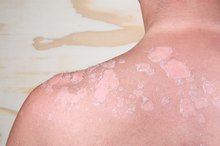White & Dark Circles on Skin
A white or dark circle on your skin may indicate a health condition or nothing at all. When you notice the appearance of new pigmentation you suspect could be skin cancer, see a dermatologist 2. Additionally, individuals with increased risk factors for skin cancer should also seek a consultation with a dermatologist upon first appearance of any skin abnormality 2.
Identification of Halo Moles
A mole with a white ring around it is called a halo mole or halo naevus and commonly found on children or young adults. Halo moles develop and senesce in four stages 1. In the first stage the white halo surrounds the mole, followed by the center mole becoming pinker in color, less pigmented or fading away. During the third stage expect the white circle of depigmentation to persist. Finally, the white circle returns to the normal color.
- A mole with a white ring around it is called a halo mole or halo naevus and commonly found on children or young adults.
- During the third stage expect the white circle of depigmentation to persist.
Causes of Halo Moles
White Blotches on the Chest
Learn More
Your body produces a halo mole as part of an autoimmune process to destroy an existing mole. Recognizing the pigmentation of an existing mole as abnormal, your body sends white blood cells to attack the mole. The reaction allowing the body to break down the mole's pigmentation affects the pigment of the normal skin surrounding it, too. This presents as a white circle.
- Your body produces a halo mole as part of an autoimmune process to destroy an existing mole.
- Recognizing the pigmentation of an existing mole as abnormal, your body sends white blood cells to attack the mole.
Melanoma
A dark circle on the skin, and rarely a halo mole, may indicate melanoma. A melanoma represents the gravest type of skin cancer. The early stages of melanoma are characterized by a dark-pigmented circle growing within the upper layers of your skin without the formation of nodules. This radial growth period can last months or years. If you think the dark circle on your skin is melanoma, contact your health professional immediately, as early treatment can reduce health risks.
- A dark circle on the skin, and rarely a halo mole, may indicate melanoma.
- If you think the dark circle on your skin is melanoma, contact your health professional immediately, as early treatment can reduce health risks.
Supernumerary Nipples
Why Is a Mole Raising Up on Skin?
Learn More
A dark circle appearing on your skin in the area between your armpit and your groin may be a supernumerary nipple. The appearance of a small, unformed “third nipple” is fairly common, according to the University of Maryland Medical Center, and is also known as polymastia, polythelia and accessory nipples.
Tinea
Tinea is a fungal infection that shows as a dark red ring on the skin. This skin condition is also called ringworm because the circle looks like a thin worm lying just underneath the skin. Starting as a small, pea-sized circle, the ring spreads out into a larger circle if left untreated. Tinea can present on the head, arms, legs or chest.
- Tinea is a fungal infection that shows as a dark red ring on the skin.
Related Articles
References
- DermNet NZ: Halo Moles
- Skin Cancer Net: When to See a Dermatologist
- National Cancer Institute. Common moles, dysplastic nevi, and the risk of melanoma. Updated April 27, 2018.
- American Academy of Dermatology. Moles: Overview.
- American Academy of Dermatology. Moles: Who gets and types.
- American Cancer Society. Tests for melanoma skin cancer. Updated August 14, 2019.
- American Cancer Society. Can melanoma skin cancer be prevented? Updated August 14, 2019.
- American Cancer Society. Key statistics for melanoma skin cancer. Updated January 8, 2020.
- Cleveland Clinic. Q&A Freckles and your skin.
- Cleveland Clinic. How to get rid of age spots (liver spots) and avoid more. March 12, 2020.
- American Academy of Dermatology. 5 reasons to see a dermatologist for mole, skin tag removal.
Resources
Writer Bio
Victoria Weinblatt began writing articles in 2007, contributing to The Huffington Post and other websites. She is a certified yoga instructor, group fitness instructor and massage therapist. Weinblatt received her B.S. in natural resources from Michigan State University and an M.Ed. from Shenandoah University.









